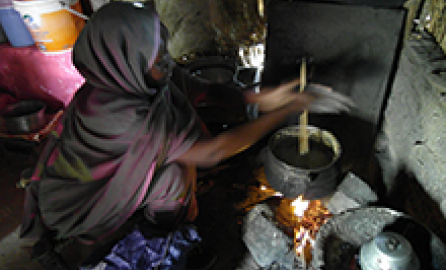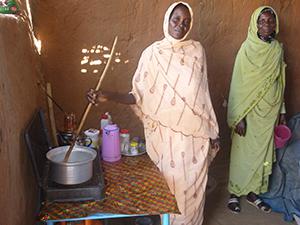Some people hope that a dream kitchen will make them happier. The life of one woman in Darfur has been transformed by a $100 gas stove.
Cooking with a traditional, open stove made out of stones, the woman’s hands and feet always suffered cuts because of the need to collect firewood every day, said Muna Eltahir, Country Director for Sudan of Practical Action. During the long hours this required, the woman’s daughters had to stay home to take care of their younger siblings.
“Now my hands are healthy,” she told Eltahir in March. “My girls are free to go to school. And I have enough time to do handicrafts, which I sell in the market, so they are a source of income.”
Clever financing is giving some of the world’s poorest people the chance to live less painful, more productive lives, as well as reducing the death and environmental damage caused by open stoves. The Darfur Low-Smoke Stoves Project, launched by Carbon Clear and Practical Action and funded through the sale of carbon credits, is distributing clean cook stoves that people can pay for with a year of $8 monthly instalments.
Traditional cooking stoves are known as the silent killer, because of their quietly devastating effects on the people who use them. About half the people in the world cook and heat their homes using open fires or leaky stoves that burn solid fuels such as coal, wood, charcoal, animal dung and crop waste. Typically, these consist of three stones arranged in a triangle with gaps at the corners to let air in.
These traditional stoves release high levels of smoke from their open fires, filling the air inside people’s homes with a range of pollutants, including soot particles that penetrate the lungs. According to the World Health Organization (WHO), this results in some 4.3 million deaths per year from illnesses attributed to household air pollution; with people dying from pneumonia, stroke and heart and lung diseases. This is more than Malaria, HIV and tuberculosis combined. Open stoves can also cause burns and scalds, especially in households where the cooking is carried out in the main living area. Women and young children are particularly vulnerable, as they spend the most time cooking or tending the fire.
Moreover, the inefficiency of these stoves means they require a lot of fuel. That forces people to spend time searching for what they need, when they could instead be earning money, studying, or simply spending more time with their relatives. Research suggests that a large number of women – and often children – can spend a significant amount of time collecting wood; in Nigeria the average is around 20 minutes a day, while in neighbouring Niger the average goes up to 4 hours a day.
The demand for wood as fuel accounts for nearly half the trees removed from the world’s forests, and more than three quarters in Africa and Asia. Stoves are also the source of nearly a quarter of emitted soot – or black carbon – produced in the world, which traps heat in the atmosphere.
“Donor governments and national governments have shown relatively little interest, because when we talk about energy we normally think about lights and television,” said Aaron Leopold, Global Energy Representative at Practical Action. “The most important energy source for all of us is the energy to make and to consume food. You know, we all cook every day, or we eat cooked food every day, and it is the main social activity in all of the households in these communities, where three-stone fires are still the main energy source.”
There are a number of ways to improve stoves. Hoods and chimneys can divert much of the smoke from a solid fuel fire, for example. Building walls out of clay retains heat and means a stove can operate on less fuel.
Practical Action is supplying stoves that burn liquid petroleum gas (LPG), which gives off no smoke at all.
“It reduces the diseases by 80%, reduces deforestation, reduces number of hours spent in cooking, taking more girls to school, doing gender equality,” said Eltahir. “We believe it is very important to widen our target people, widen our geographical location as well.”
Carbon Clear is helping to finance the gas stove project through carbon credits bought by companies in the industrialised world. Buyers offset their carbon footprint by funding reductions of greenhouse gas emissions elsewhere. A carbon credit is issued for each tonne of carbon dioxide equivalent avoided or reduced, but to qualify for carbon credits, a project must demonstrate that people who use the clean stoves are producing less carbon dioxide than they did before, when they were using open stoves.
“We calculate the emissions from traditional cooking with wood and charcoal, taking a broad approach: combustion of this biomass, manufacturing of the charcoal, cutting of the wood, transporting the wood and charcoal to the area where it's consumed,” said Olivier Levallois, Carbon Projects Manager at Carbon Clear. “On the other side, we measure the quantity of carbon emitted by the gas and other fuels used. When we compare them, we are able to demonstrate emission reductions with very broad considerations.”
Carbon finance has been applied to other technologies too. Many people purify water by boiling it over wood or charcoal fires. But water filters can do this job without burning fuel, so they qualify for carbon credits.
“The range of technologies to have access to this type of mechanism has increased,” said Levallois. “The number of projects has increased. There is a growing interest also from companies to be able to channel finance more easily to development projects.”
The principle is simple. But to qualify for finance, it is necessary to have the carbon credits certified by an outside body to show that the emissions reduction is really happening. That can be complicated, and is an ongoing task for Carbon Clear.
“The increasing environmental integrity of the mechanism has added layers of complexity to ensure that the projects were actually enabling additional greenhouse gas emission reduction” said Levallois. “More recently, we have talked about smaller projects and access to this type of financing by organisations with less technical knowledge. There has been a wave of simplifying methodologies, but it still requires some technical knowledge. So, today it is still difficult for a very small entity to have access to carbon finance because of the resources required to do so.”
The three interviewees were in Brussels to attend the European Development Days panel on Cooking on gas: can fossil fuels save lives and reduce deforestation. You can listen to an audio recording of the event here. You can also find out more about cookstoves in the Public Group on Energy or in the links below:
- Poor people’s energy outlook 2014 – a Practical Action report
- Making Climate Change Mitigation More Meaningful – a Practical Action report by Aaron Leopold
- Momentum for Change - Darfur project page.
- Energy Facility Monitoring Thematic fiches on the Gold standard, Micro finance or Clean cook stoves
- The Household Energy Network
- The GIZ HERA Cooking Energy Compendium – a practical guidebook for implementers of cooking energy innovation
This collaborative piece was drafted by Sebastian Moffettwith support from the capacity4dev.eu Coordination Team.



(2)
Log in with your EU Login account to post or comment on the platform.
I agree cooking with gas saves time, it's convenient and spares any inconveniences pertaining to health. In most villages especially in under/developing countries in Africa, cooking on three stone fire side kitchen as it is commonly referred to is what is adopted. Back in Cameroon, Douala precisely I use a stove that works with coal. Coal is what is collected after wood has been burnt, and this is so convenient. It does not produce smoke yet the heat it produces cooks faster than on gas. Many people use this instead to save gas, because it is more economical.
My room is on the first floor, while the kitchen is on the ground floor, so my husband has bought the best portable induction cooktop for our room as it will help us to feed milk to our growing son, who often awakes at midnight with hunger. It also helps us to prepare our morning coffee in the room, when it is chilly outside.